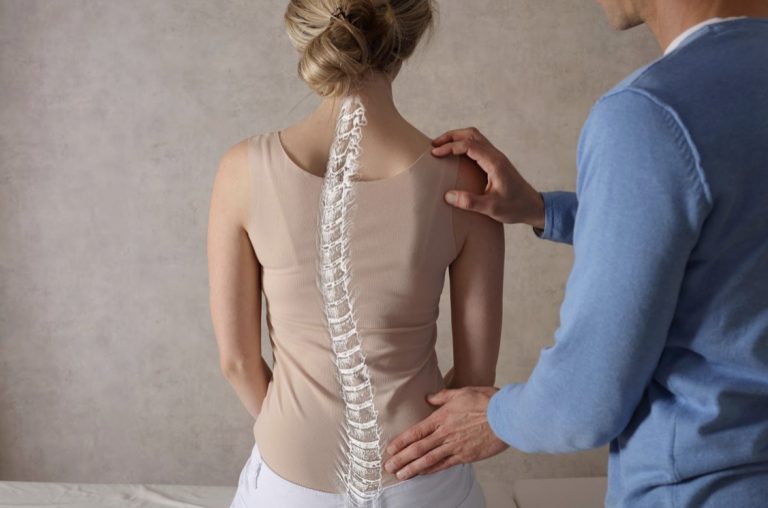Scoliosis is abnormal lateral, or side-to-side, the curvature of the spine. While most people may be familiar with scoliosis being diagnosed among the adolescent population, there is actually more than one type of scoliosis and the condition can develop among people of all ages. While mild scoliosis may not result in symptoms or mobility problems, it can become progressive and have a severe effect on your quality of life.
Whether you have been living with scoliosis, or you are learning about causes of back pain, information is an important step in the treatment journey. That’s why we’ve put together the following guide to the types of scoliosis, their symptoms, and potential treatment options.
If you’re interested in learning more, feel free to contact the BEST Health System team today. We’ll be glad to assist you on your journey to relief.
Recognizing normal and abnormal spinal curvature
When viewed from the side, the spine should have some curvature. This is what gives the spinal column its recognizable “S” shape. These natural curves can develop excessive curvature due to a number of factors including congenital defects and aging. The terms lordosis and kyphosis are used to describe the disorders related to these curvatures becoming excessive.
Scoliosis is excessive spinal curvature of a different kind. When viewing the spine from the front or back, the spine should appear straight up and down, as opposed to the S-shape you see from the side. Scoliosis is defined as left or right curvature greater than 10 degrees.
Scoliosis can be further divided into these three classes of severity:
- Mild scoliosis — Between 10 and 25 degrees of curvature
- Significant scoliosis — Between 25 to 45 degrees of curvature
- Severe scoliosis — Greater than 45 degrees of curvature
Scoliosis is not necessarily painful, particularly if you have mild scoliosis. However, it can result in visible deformity, posture, and mobility problems no matter what type of scoliosis you have.
Treatment for scoliosis is dependent on both the degree of curvature as well as the specific type you have been diagnosed with.
Idiopathic scoliosis
Idiopathic scoliosis is the type most people are familiar with and it is also the most common, comprising 80 percent of all diagnoses by some estimates. Idiopathic conditions are medical problems that arise spontaneously and for which there is not a known cause. In the case of idiopathic scoliosis, it is the diagnosis that doctors use when there is no other known cause, including genetics, a neuromuscular condition, or age-related degeneration.
Idiopathic scoliosis is most frequently diagnosed in young people, especially girls, and is often associated with periods of growth. In many cases, adolescent idiopathic scoliosis is usually temporary, with patients growing out of the disorder with the help of a brace and other interventions.
Congenital scoliosis
This type of scoliosis develops due to problems during the growth of an embryo in the womb. Congenital scoliosis is usually diagnosed at birth or very early in life and occurs in a very small fraction of the population. There are a number of specific issues that can cause abnormal curvature as the spine begins to develop before birth, including:
- Incomplete formation of the vertebrae
- Failure of one or more vertebra to separate
- Combination of incomplete vertebral formation and failure to separate
- Compensatory curvature
Congenital scoliosis is usually not painful and detected by sight by a pediatrician, a parent, or even the child as they grow older. In the most severe cases, congenital scoliosis can require surgery where there is a significant deformity.
Neuromuscular scoliosis
This is scoliosis related to a neuromuscular condition. Neuromuscular scoliosis is often a secondary effect of neurological conditions or muscular disorders due to their disrupting nerves and/or muscles around the spine. Underlying causes of neuromuscular scoliosis include spinal cord trauma, spina bifida, cerebral palsy, muscular dystrophy, and atrophy of spinal muscles.
Like other forms, this type of scoliosis is also common in adolescents. Neuromuscular scoliosis is identified with visible unevenness of the shoulders, prominence of the ribs, and a pelvic tilt. As scoliosis is a common byproduct of many neuromuscular conditions, doctors will monitor for spinal curvature in patients with underlying conditions.
Treatment for neuromuscular scoliosis involves a combination of bracing, wheelchair modification if needed, and physical therapy. Surgery may be able to slow down the progression of curvature in severe cases.
Degenerative scoliosis
Also known as adult-onset scoliosis, this type is caused by the natural breakdown of spinal joints and discs that lead to excessive lateral curvature. Degenerative scoliosis can occur in patients with spinal arthritis and degenerative disc disease. Patients who have previously been diagnosed with another form of scoliosis may also be at risk.
Degenerative scoliosis can go undiagnosed for many patients, particularly if it is a milder form that does not cause symptoms. In other cases, neuropathic symptoms can develop if displaced spinal anatomy causes nerve compression.
Treatments for this type of scoliosis usually begin nonsurgically and include over-the-counter medication, physical therapy, therapeutic injections, and lifestyle changes. Surgery can become an option if the progression of curvature is accelerating and causing pain and mobility problems.
Learn about the full range of treatments for scoliosis
Scoliosis can seriously disrupt your quality of life but is a manageable condition. Whether you are exploring initial treatment or the possibility of surgery, the caring and knowledgeable team at BEST Health System can help. Our talented experts have years of experience helping patients with a wide range of spine conditions, including scoliosis, find the relief needed for a better quality of life.
To learn more, contact us today or call us toll-free at 1-513-540-0809
